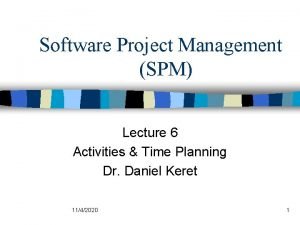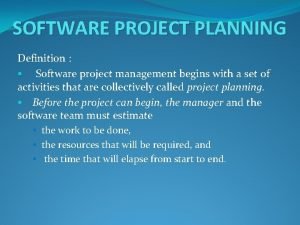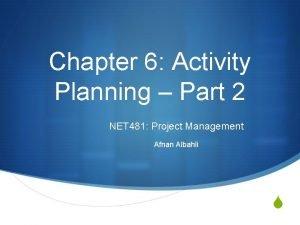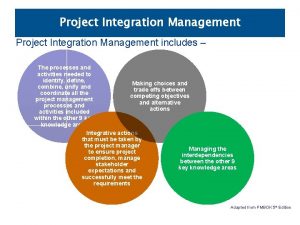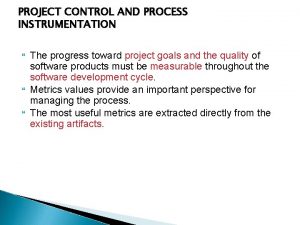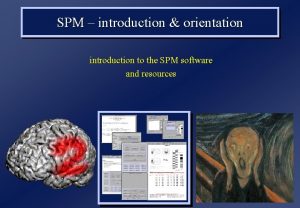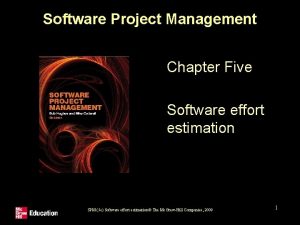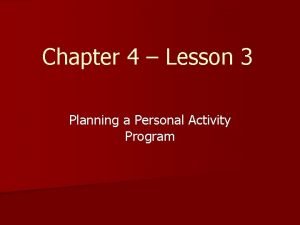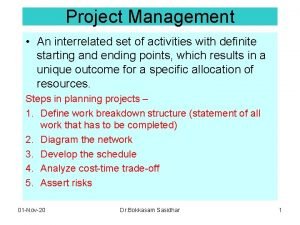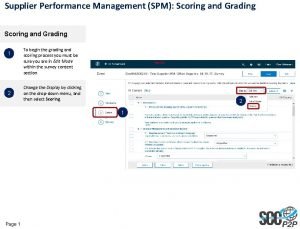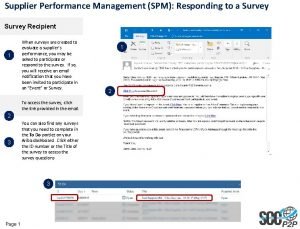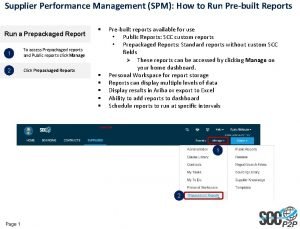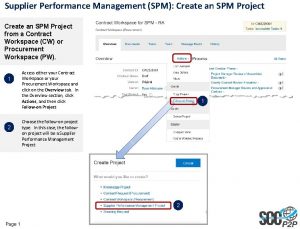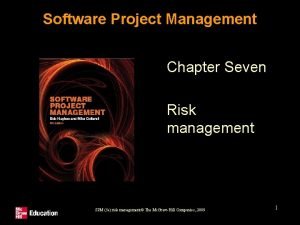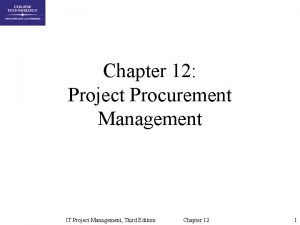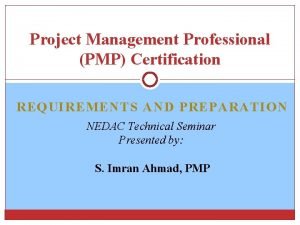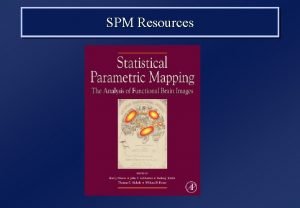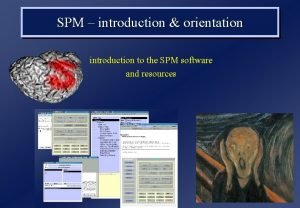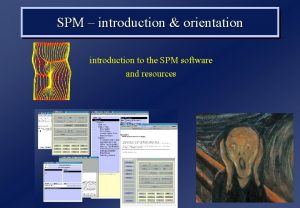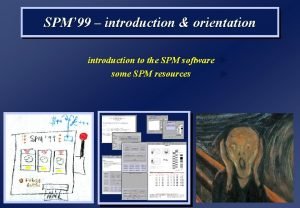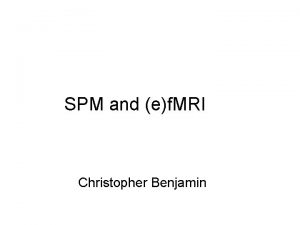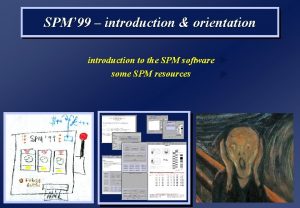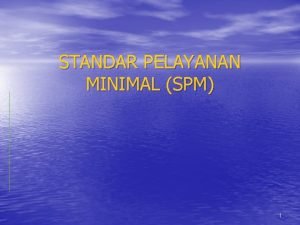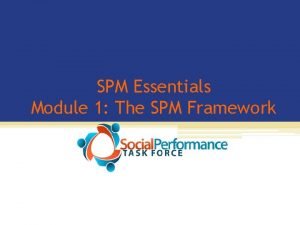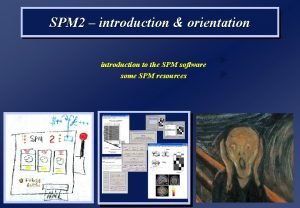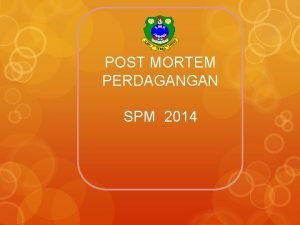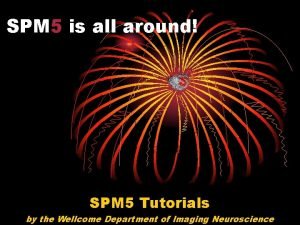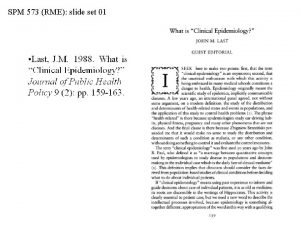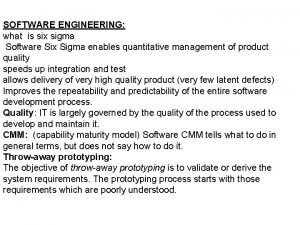Software Project Management Chapter Six Activity planning SPM




























- Slides: 28

Software Project Management Chapter Six Activity planning SPM (5 e) Activity planning© The Mc. Graw-Hill Companies, 2009 1

Scheduling ‘Time is nature’s way of stopping everything happening at once’ Having worked out a method of doing the project identified the tasks to be carried assessed the time needed to do each task need to allocate dates/times for the start and end of each activity SPM (5 e) Activity planning© The Mc. Graw-Hill Companies, 2009 2

Activity networks These help us to: Assess the feasibility of the planned project completion date Identify when resources will need to be deployed to activities Calculate when costs will be incurred This helps the co-ordination and motivation of the project team SPM (5 e) Activity planning© The Mc. Graw-Hill Companies, 2009 3

Defining activities Activity networks are based on some assumptions: A project is: Composed of a number of activities May start when at least one of its activities is ready to start Completed when all its activities are completed SPM (5 e) Activity planning© The Mc. Graw-Hill Companies, 2009 4

Defining activities -continued An activity Must have clearly defined start and end-points Must have resource requirements that can be forecast: these are assumed to be constant throughout the project Must have a duration that can be forecast May be dependent on other activities being completed first (precedence networks) SPM (5 e) Activity planning© The Mc. Graw-Hill Companies, 2009 5

Identifying activities Work-based: draw-up a Work Breakdown Structure listing the work items needed Product-based approach list the deliverable and intermediate products of project – product breakdown structure (PBS) Identify the order in which products have to be created work out the activities needed to create the products SPM (5 e) Activity planning© The Mc. Graw-Hill Companies, 2009 6

Hybrid approach SPM (5 e) Activity planning© The Mc. Graw-Hill Companies, 2009 7

The final outcome of the planning process A project plan as a bar chart SPM (5 e) Activity planning© The Mc. Graw-Hill Companies, 2009 8

PERT vs CPM Do B PERT Do A Do D Do C CPM Do A Do B Do D Do C SPM (5 e) Activity planning© The Mc. Graw-Hill Companies, 2009 9

Drawing up a PERT diagram No looping back is allowed – deal with iterations by hiding them within single activities milestones – ‘activities’, such as the start and end of the project, which indicate transition points. They have zero duration. SPM (5 e) Activity planning© The Mc. Graw-Hill Companies, 2009 10

Lagged activities where there is a fixed delay between activities e. g. seven days notice has to be given to users that a new release has been signed off and is to be installed Acceptance testing 7 days Install new release 20 days SPM (5 e) Activity planning© The Mc. Graw-Hill Companies, 2009 1 day 11

Types of links between activities Finish to start Software development Acceptance testing Start to start/ Finish to finish Test prototype 2 days 1 day Document Amendments SPM (5 e) Activity planning© The Mc. Graw-Hill Companies, 2009 12

Types of links between activities Start to finish Operate temporary system Acceptance test of new system Cutover to new system SPM (5 e) Activity planning© The Mc. Graw-Hill Companies, 2009 13

Start and finish times Latest finish Earliest start activity Earliest finish Latest start Activity ‘write report software’ Earliest start (ES) Earliest finish (EF) = ES + duration Latest finish (LF) = latest task can be completed without affecting project end Latest start = LF - duration SPM (5 e) Activity planning© The Mc. Graw-Hill Companies, 2009 14

Example earliest start = day 5 latest finish = day 30 duration = 10 days earliest finish = ? latest start = ? Float = LF - ES - duration What is it in this case? SPM (5 e) Activity planning© The Mc. Graw-Hill Companies, 2009 15

‘Day 0’ Note that in the last example, day numbers used rather than actual dates Makes initial calculations easier – not concerned with week-ends and public holidays For finish date/times Day 1 means at the END of Day 1. For a start date/time Day 1 also means at the END of Day 1. The first activity therefore begin at Day 0 i. e. the end of Day 0 i. e. the start of Day 1 SPM (5 e) Activity planning© The Mc. Graw-Hill Companies, 2009 16

Earliest start Duration notation Earliest finish Activity label, activity description Latest start Float Latest finish SPM (5 e) Activity planning© The Mc. Graw-Hill Companies, 2009 17

Complete for the previous example SPM (5 e) Activity planning© The Mc. Graw-Hill Companies, 2009 18

Forward pass Start at beginning (Day 0) and work forward following chains. Earliest start date for the current activity = earliest finish date for the previous When there is more than one previous activity, take the latest earliest finish EF = day 7 ES = day 10 EF = day 10 SPM (5 e) Activity planning© The Mc. Graw-Hill Companies, 2009 19

Example of an activity network SPM (5 e) Activity planning© The Mc. Graw-Hill Companies, 2009 20

Complete the table SPM (5 e) Activity planning© The Mc. Graw-Hill Companies, 2009 21

Backward pass Start from the last activity Latest finish (LF) for last activity = earliest finish (EF) work backwards Latest finish for current activity = Latest start for the following More than one following activity - take the earliest LS Latest start (LS) = LF for activity - duration SPM (5 e) Activity planning© The Mc. Graw-Hill Companies, 2009 22

Example: LS for all activities? SPM (5 e) Activity planning© The Mc. Graw-Hill Companies, 2009 23

Complete the table SPM (5 e) Activity planning© The Mc. Graw-Hill Companies, 2009 24

Float = Latest finish Earliest start Duration FLOAT LF ES activity Latest start Earliest finish SPM (5 e) Activity planning© The Mc. Graw-Hill Companies, 2009 25

Complete the table SPM (5 e) Activity planning© The Mc. Graw-Hill Companies, 2009 26

Critical path Note the path through network with zero floats Critical path: any delay in an activity on this path will delay whole project Can there be more than one critical path? Can there be no critical path? Sub-critical paths SPM (5 e) Activity planning© The Mc. Graw-Hill Companies, 2009 27

Free and interfering float 0 7 w 7 B can be up to 3 days late and not affect any other activity = free float A 2 2 9 0 4 w 4 w 44 7 BB 5 0 5 8 10 D 9 9 2 2 w 12 E 10 10 0 12 10 w 10 A 0 1 w 0 10 B can be a further 2 days late – affects D but not the project end date = interfering float SPM (5 e) Activity planning© The Mc. Graw-Hill Companies, 2009 28
 Step wise project planning
Step wise project planning Activities covered by spm
Activities covered by spm What is the first activity in software project planning?
What is the first activity in software project planning? Software project estimation can never be an exact science
Software project estimation can never be an exact science Activity based approach in software project management
Activity based approach in software project management Modern project profiles in software project management
Modern project profiles in software project management Project evaluation in software project management
Project evaluation in software project management Improving software economics
Improving software economics Importance of software project management
Importance of software project management Ieee 828
Ieee 828 Six processes of project integration management
Six processes of project integration management What is project control and process instrumentation
What is project control and process instrumentation What is spm software
What is spm software Software effort estimation in spm
Software effort estimation in spm Glencoe health chapter 12
Glencoe health chapter 12 Chapter 12 lesson 3 planning a personal activity program
Chapter 12 lesson 3 planning a personal activity program Chapter 4 physical activity for life
Chapter 4 physical activity for life Concurrent activity in project management
Concurrent activity in project management The intent of project metrics is:
The intent of project metrics is: Classify each polygon
Classify each polygon Grading spm
Grading spm Spm supplier performance management
Spm supplier performance management Spm supplier performance management
Spm supplier performance management Spm supplier performance management
Spm supplier performance management Risk management in spm
Risk management in spm Solicitation planning in project management
Solicitation planning in project management Resource loading definition
Resource loading definition Pmp certification timeline
Pmp certification timeline Corporate strategy meaning
Corporate strategy meaning

